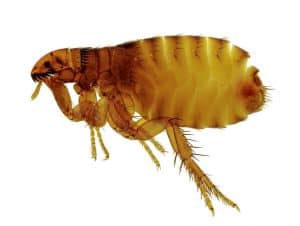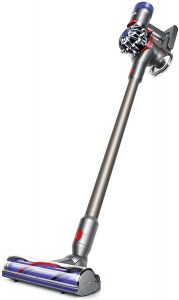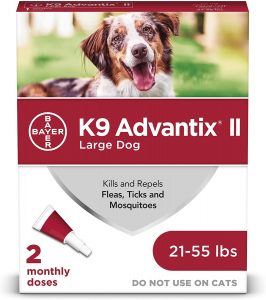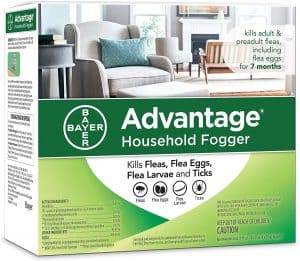Killing dog fleas is not a one time job that is completed in one day. Getting rid of an infestation could take multiple days, weeks or even months. Because of the life cycle of a flea, you need very specific tools and tips for getting the job done right, so here is a complete guide on how to keep dog fleas out of your house.
To fully eliminate dog fleas from your house you must first identify the problem areas of your home then pinpoint the infested areas. Part of your action plan should include vacuuming, washing sheets and bed spreads, treating pests, full home extermination and flea sprays.
How to Get Rid of Fleas in the House Forever
8 Step Guide to Get Rid of Fleas
 Identify The Problem
Identify The Problem- Pinpoint Infested Areas
- Create An Action Plan
- Vacuum Everything
- Wash Sheets And Bedding
- Prepare Pets
- Pick Your Flea Extermination Solution – Use Flea Sprays or Use Flea Foggers or Call Pest Control Services
- Finish The Flea Removal Job
1. Identify The Problem in Your Home (Are they really fleas?)
Before you do anything else, you need to identify whether or not you even have a flea problem to begin with. There are various things you can check for or even test to see if an infestation is already underway. Some of these include:
 Powdered Deposits
Powdered Deposits
Brown, white, or black mounds of an odd substance found in your bedding or carpet are not good signs when it comes to flea infestations. Part of this substance (usually the white) is eggs that the fleas have laid. The black substance is, unfortunately, the digested blood that it has eaten, digested and then pooped. If you aren’t sure whether or not this black substance is flea poop or just something else random, a good test you can do is to put the small black pieces you find in water and see if they stay black, or turn into a brown or reddish color. If they do, it is most definitely flea poop.
- Hair Loss
There are some kinds of fleas that will activate an odd reaction in your pets. This reaction is called alopecia. Alopecia causes the hair to fall out in some infested areas of your pet’s fur and can be really uncomfortable for the pet. If this is a big concern, we recommend taking your pet to the nearest vet and then addressing the issue further.
- Sock Riders
A lot of us walk through the house with socks on, so this is an easy one to catch. Check your socks to see if any fleas have hitched a ride as you were strolling down the hallway. Fleas will often jump out of the carpet and then land on the lower parts of your legs. This is why most bites are found in this area. If you are wearing white socks, you will be able to see the fleas a lot more clearly than if you were wearing darker or faded socks.
2. Pinpoint The Flea Infested Areas of You Home
If you have tested out a few of the things above and found that you do indeed have a flea problem, you will want to move on to find out exactly where those little pests are hiding. Some of their favorite hiding places include:
- Under rugs and carpets
Fleas are really good at finding hiding places, and one of their favorites is on and under rugs and carpets in apartments or houses. Studies show that adult females can lay around 50 eggs in just one day. These flea babies eat the poop of the fleas that are left around and have a huge supply to live on when there is an infestation.
Because the larvae are in the carpet or rug, the fibers actually protect them and keep them immune from any chemicals you might be trying to use against them. That’s why it’s always a good idea to continually vacuum your home, so you get rid of them before they hatch.
- Under leaf piles
Outside, one of their favorite places to hide is underneath leaf piles. This kind of environment is perfect because it is usually a humid atmosphere which is great for reproduction. This location is also dark, so it keeps them out of the sunlight which they hate. Raking the leaves in your yard is never a bad idea to help avoid this kind of problem.
- In Your Bed And Mattresses
A lot of us can deal with the fact that fleas are outside, but when we hear that fleas can live in our beds that’s where we draw the line. One of their favorite places to hide is inside mattress covers and inner material where we can’t get to them easily. In the same way as the carpet, the adults leave poop that the babies can eat, thus spreading the infestation.
- In Cracks And Crevices
There are more cracks in your home than you would ever think, and fleas love them. There are cracks in your baseboards and even in your hardwood floor that they can sneak into. These kinds of cracks give the fleas a safe place from any potential damage that you would inflict during your process of extermination.
- Pets Feeding Area
A lot of pets live outside and therefore eat outside. With feeding your pet outside however, you could accidentally be creating the perfect breeding ground for fleas.
Since fleas are pretty smart, they know exactly when your pet will be hanging around for dinner and will use the opportunity to hitch a ride. Cleaning your pets feeding area regularly will help fix this problem.
3. Create A Flea Removal Action Plan
Once you have identified the key areas where fleas are located in your home, now it is time to act on it by putting together an action plan. Fleas are a common problem for pet owners, but they don’t have to be your problem any more. With a little effort and the right plan, you can keep them off of your furniture, out of your carpets and away from your pets. Fleas don’t live on just any animal, they are most commonly found on cats and dogs. A good start would be to contain your pets so they aren’t spreading fleas as you begin the process.
4. Vacuum Everything In Your House
You will most definitely want to vacuum everything that can be vacuumed. Carpets, rugs, couches, bed and even your hardwood floors will need to be vacuumed. Be sure and throw out the vacuum bags that you use to ensure that the problem doesn’t come back.
A great option to use is a Dyson V8 Animal Cordless Stick Vacuum Cleaner that can be easily cleaned and emptied.

5. Wash Sheets And Bedding
The thing you can do is be sure to wash all of your clothes, towels, sheets, and bedding. Fleas love to hide in fibers, so you can never wash too many things in your home. Be sure and use hot water when you are doing the laundry. This will make sure the fleas that are caught die in the process.
6. Prepare Pets
If your pet has fleas, a great first step is to make sure you are using some kind of flea & tick medication. Apply this to your pet regularly leading up to your extermination day, and be sure not to give them a bath too soon after you apply the medicine. If they bathe too soon, it could accidentally wash off the medication that was applied, unintentionally inviting the fleas back.
7. Pick Your Flea Extermination Solution
Once you have created a plan and have prepared, you’ll want to decide upon a chemical solution to deal with them. There are many varieties of methods available today that would be great options, but here are just a few you can choose from:
Flea Sprays vs. Flea Foggers vs. Pest Control
Use Flea Sprays
Flea sprays are a great option because they can be used on a variety of surfaces. If you are looking for a quick and easy method, pick a flea spray and begin to spray it on rugs, carpets, furniture, bedding and anything else that might be infested. These sprays will kill most types of fleas, and will also kill their eggs in the process.
Use Flea Foggers
Fogging your home is a great method to use because the poison reaches the hard to get to places like under baseboards and behind furniture. The downside of this method is that it is a little inconvenient because you and any pets will need to stay out of the home for pretty much the whole day while the poison does its work. You will need to cover anything valuable or edible and even temporarily disable your smoke detector. Despite these downsides, fogging will usually get the job done in a couple of tries.
Call Pest Control Services
While a lot of products on the market are effective against pests, nothing really compares to hiring professionals to come to handle the job for you. The years of expertise that pest control companies bring to the table are simply priceless compared to typical store-bought poisons. If you have an especially bad infestation at your home, you will want to seriously consider hiring a professional who can identify just exactly how bad the problem is, and what the solution should be. Check with your local pest control service today!
8. Finish The Flea Removal Job
After you have identified the problem, made a plan and executed the plan, you want to make sure that you finish the job. The biggest mistake people make with flea infestations is to quit before all the fleas are dead. Stay persistent using the methods above to ensure that you have a long-lasting and flea-free home for years to come. Some things that you can do to make sure fleas stay gone are:
- Continue To Vacuum
- Continue To Wash Bedding Regularly
- Keep Pet Feeding Area Clean
- Continue To Medicate Pets Against Fleas
- Watch Out For Beginning Signs Of Fleas Returning
We hope that you have found this guide helpful in your battle against flea infestation. We are confident that if you continue using these tips and tricks, fleas will want to be anywhere except your home. You can also see our other tips on eliminating termites naturally, eliminating gnats and eliminating bed bugs.




